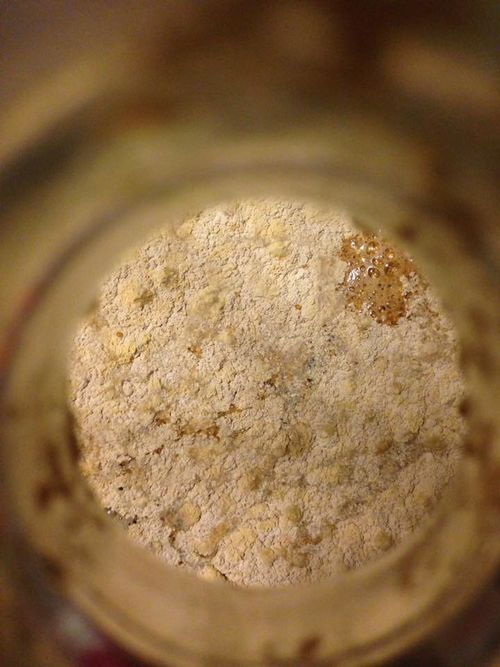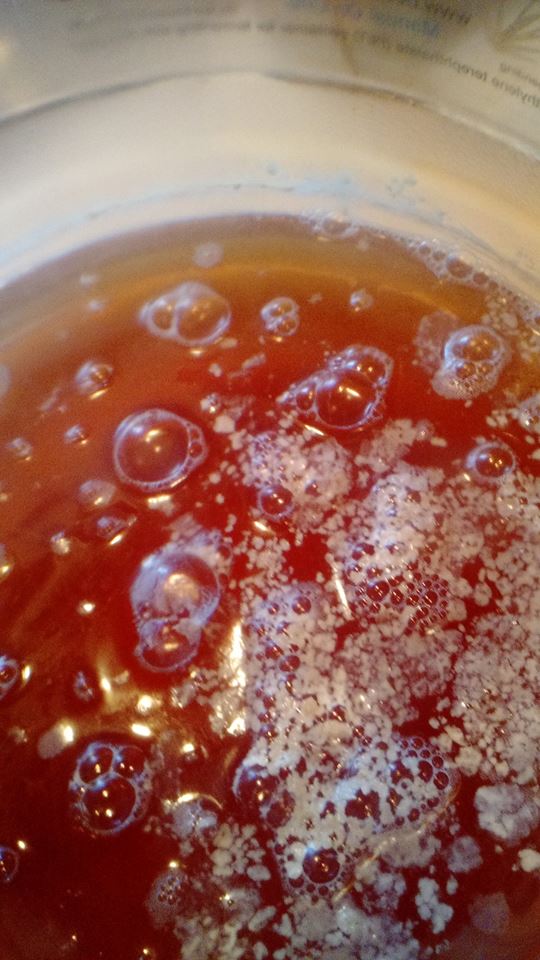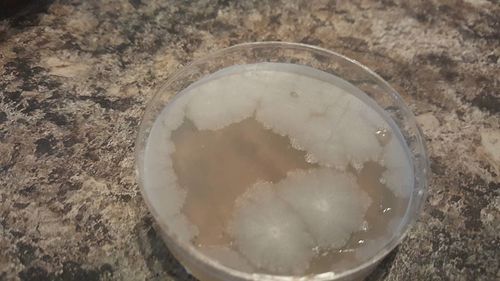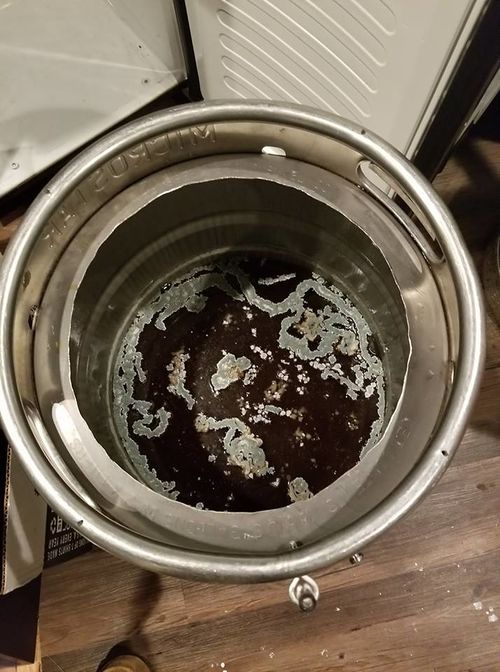Mold
Mold (US) or mould (UK) are multicellular fungi that grow in the form of filaments called hyphae that appear like long branch-like structures under a microscope. Although not a taxonomic designation, there are an estimated 10,000 - 300,000 of species of molds that live in a wide variety of environments [1]. In general they cause biodegredation of foods and other natural materials (such as wood in buildings), which has a wide role of effects depending on the species of mold. For example, some species of mold can be the cause of food spoilage, and other species play an important role in food production such as in cheese and soy sauce production [2]. Certain species of mold are thought to contribute precursors that effect flavor production in the toasting of oak barrels [3] Molds have also been used in the pharmaceutical industry to produce antibiotics and other medicines. Certain molds can cause allergic reactions as well as diseases from mold growth within the body or from mycotoxin production in exposed foods or from breathing spores from mold growth in buildings [2].
Contents
Mold in Beer and Health Concerns
Mold Growth in Beer
Although little studying has been done on mold growth in beer, it has been known to occur in barrel aged beers are fruited sour beers. Oxygen generally needs to be present in order for mold to grow. Mold growth on fruit that is in sour beer can occur if the fruit is floating above the surface of the beer, and enough oxygen is present (either from vacuum suck-back, the oxygen permeability of the vessel, or sampling). For this reason, many commercial sour brewers will "punch down" the fruit frequently with a dish-like tool.
Mold Growth in Wild Mead
It has been demonstrated that while honey is antimicrobial due to its high sugar concentration and low water concentration, which inhibits the growth of microbes, honey is not inherently pasteurized and sanitary. Low levels of molds, yeasts, and spore-forming bacteria can survive in honey and can begin to grow once the honey is diluted with water as it is in mead-making. It is thought that most of the microbes found in finished honey originate from the handling of the honey, and do not originate from the hive, although some microbes may be introduced from the bees [4]. It is therefore possible that mold growth can occur during mead making if the mead does not begin to ferment in a timely manner, for example, for wild/spontaneous fermentation [5]. To prevent mold growth during wild fermentation of mead (with no lab yeast pitched), purging the vessel with CO2 until after the mead begins actively fermenting should help reduce the chances of mold growth.
Preventing Mold Growth
- If aging sour beer on whole fruit, use a punch-down tool frequently so that the low pH kills any mold that might be present before it begins to grow. CO2 may be helping the fruit to float, and punching-down the fruit will help to release that CO2. Homebrewers can gently swirl their carboys to accomplish the same thing. Purging the headspace with CO2 will also help prevent mold growth.
- Limit oxygen exposure to the beer.
- Use diligent sanitation practices.
- Inspect barrels for mold prior to use; discard barrels that have mold growth, or disassemble the barrel and vigorously clean/sanitize the wood before use. See the Barrel page for details on storing and maintaining barrels.
- Mold is tolerant of both hops and alcohol levels above what is in beer (50-60% ABV), so do not rely on hops or alcohol to prevent mold growth [6].
- Keep relative humidity levels under 60% and preferably between 30-50%. This level of relative humidity also falls into the preferred levels for oak barrel environments [7].
Health Concerns
A small number of molds can produce poisonous substances called mycotoxins, or cancer-causing poisons called aflatoxins. Some molds that do not produce toxins can still cause allergic reactions or respiratory problems [1]. Their effects are cumulative, rather than immediately toxic as in the case of pathogenic bacteria. A small amount of ingested mycotoxin won't be harmful right away, but it will increase the risk of gastric, intestinal, and colon cancer, as well as other health issues [8]. As a general rule of thumb, pigmented molds (non-white/grey) are more likely to produce poisonous substances (especially black mold which could be Aspergillus), however, there are exceptions to this guideline [9]. Some mycotoxins can survive boiling temperatures in wort to varying degrees, so if mold develops during processes such as kettle souring, it is possible for some percentage of mycotoxins to survive the wort boiling process and fermentation (one study showed that 20-30% of two mycotoxins were removed during boiling and fermentation) [10]. Only mold that is growing on the beer itself is considered potentially dangerous; mold growing in airlocks or outside of vessels should not be a cause for concern as long as they do not come into contact with the beer itself. If only a small amount of mold has grown on the beer, then removing it quickly and purging the vessel with CO2 to prevent more mold growth will limit the potential for exposure to toxins. However, if a large amount of mold has grown and if it happens to be a mycotoxin-producing species, then there is a higher chance that more toxin could be in the beer [9].
Identifying mold based on what it looks like is not a reliable way to determine if a mold is a cause of concern for health [9]. If mold is present in beer, it might be possible for commercial breweries to remove the mold and send it to a lab to check if it is a toxic mold before allowing the beer to be consumed. Some homebrewers may decide to risk taking a chance that the mold will not cause illness, however, we recommend discarding beer that has come into contact with the mold, especially if serving to others. Soft fruits and vegetables with high moisture that grow mold on the surface can also be contaminated with mycotoxins or aflotoxins below the surface, therefore beer or wort that has mold growing on its surface could also be contaminated below the surface [1].
See the USDA website, this UC Davis Food safety sheet, and "Fact or Fiction? Can Pathogens Survive in Beer - Mould Edition.," by Dr. Bryan Heit of Sui Generis Blog for more information on the health concerns of mold that grows on food.
Identifying Mold
As mentioned above, identifying the species of mold based on what it looks like with the naked eye is not a reliable way to identify it at the species level, and thus not a reliable way to know if the mold growth is safe. It is, however, usually easy to tell the difference between general mold growth and pellicle or yeast growth. Mold tends to look "fuzzy" or "hairy" and often has green, red, black, white, or grey colors, where as yeast activity or pellicles tend to have evidence of CO2 production (bubbles), and looks "creamy", "powdery", or "chalky" and is never green, red, or black in color. Protein/carbohydrate coagulation can also be misidentified as mold, however this also never appears "hairy" or "fuzzy" like mold. We recommend taking a picture through a hand lens when posting an image of what might be mold as this will make it easier to identify. Be sure that the color of the mold/pellicle in the photo is accurate to what it looks like with the naked eye (sometimes cameras make white substances appear more pigmented, which can throw off attempts to identify the organism online). Please make an attempt to identify whether the growth is mold or not on your own before posting in the group (these types of posts clog the stream!). See the images below for examples that should help.
Mold vs Pellicle Examples
The following table shows examples of mold or pellicles from the Milk The Funk Facebook group, and the consensus on whether mold is likely present or not based on the image.
See Also
Additional Articles on MTF Wiki
External Resources
- USDA Website on Molds.
- "Bacteriological Analytical Manual; Chapter 18; Yeasts, Molds and Mycotoxins."; FDA Website.
- "Fact or Fiction? Can Pathogens Survive in Beer - Mould Edition.," by Dr. Bryan Heit of Sui Generis Blog.
References
- ↑ 1.0 1.1 1.2 "Molds On Food: Are They Dangerous?" United States Department of Agriculture. Retrieved 07/15/2016.
- ↑ 2.0 2.1 Mold. Wikipedia. Retrieved 07/12/2016.
- ↑ The duration effect of natural seasoning of Quercus petraea Liebl. and Quercus robur L. on the diversity of existing fungi flora and some aspects of its ecology. N. Vivas. 1996.
- ↑ Microorganisms in honey. Jill A Snowdon, Dean O Cliver. International Journal of Food Microbiology. Volume 31, Issues 1–3, August 1996, Pages 1-261996.
- ↑ [https://www.facebook.com/groups/MilkTheFunk/permalink/2140692022625667/ Adam Johnson. Milk The Funk Facebook group post on preventing mold growth. 06/21/2018.]
- ↑ Dr. Bryan Heit of Sui Generis blog. Milk The Funk Facebook group. 04/21/2017.
- ↑ "Mold". US EPA website. Retrieved 08/08/2017.
- ↑ Dr. Bryan Heit Heit. Milk The Funk Facebook group thread on the health risks of mold. 06/19/2018.
- ↑ 9.0 9.1 9.2 "Fact or Fiction? Can Pathogens Survive in Beer - Mould Edition." Dr. Bryan Heit of Sui Generis Blog. 08/11/2016. Retrieved 08/11/2016.
- ↑ Stability of mycotoxins during food processing. Lloyd B. Bullerman, Andreia Bianchini. 2007.
























